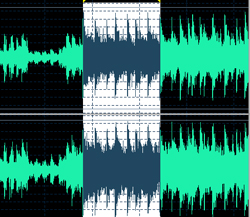
The Wide Pocket: This kind of feel really bends the idea of rhythm and groove. It makes the pulse a bit unclear, but also allows for a lot variation in the rhythmic structure. This is most common in jazz. In this case, generally, I would be very discerning as to how much editing is done – because “off” the beat becomes very musically subjective.
The Grid: In Pop, Rock, Hip Hop, and Electronica, I would say this – the kick is going to define your downbeat. Not to say that the kick will necessarily hit on the downbeat, but our ear will natural prescribe where the kick hits as the downbeat – unless it’s so far away that it just simply can’t be the downbeat.
For this reason I like to move every audio stem simultaneously so that the first kick that occurs on a downbeat is perfectly lined up with the grid. This gives me a visual sense as to how everything that comes after relates to it. This assumes that the first kick is on beat of course – if every subsequent kick on every subsequent downbeat is late – maybe that first kick was just off. But assuming it wasn’t, you now have a map for where everything else is landing.
Don’t think of the grid as a blueprint – you could literally have nothing hitting square on the tempo grid and still have a perfectly timed piece. Think of the grid as a reference point. If things are changing radically from where they normally land relative to the grid, you probably have an off-moment. It should also sound or feel off-beat. If it doesn’t, then ignore the grid. If it does – use the grid as an idea as to where the hits should be landing.
Doubled Parts – I find doubled parts, particularly vocal adlibs, to be most effective when they are as tight to the lead track as possible. But again, no rules.
Clean Up
Hum, Hiss, Breathes, Farts – these are things that while they can have their place, generally are best left out of the record. With hums and hiss, noise reduction software is generally most effective. Most of this software comes with a price – so think of it as noise reduction, rather than noise removal. Too much usually compromises the audio.
With breathes, there’s some negotiation. Logically one would think if the music is sparse than you should probably get rid of the breaths as they will be more audible, and if the music is busy it really doesn’t matter if you leave them in. Well – I find that not to be the case. In sparse music, I find it strange if I don’t hear the vocalist breathe to some degree. I also don’t want to hear an asthma attack in the record – so the best bet is to volume ride the breathes down about 10 dB.
In busy music, the vocals are probably getting a lot more compression, and this is going to pull the breaths up in the mix and cloud up whatever else is going on. Here I would most likely completely remove the breathes.
Compositing
Compositing is taking the best moments from the best takes and creating one super awesome performance. No EQ, Reverb, Delay, Phasing, Flanging, Twizzle-Flanging, or Compression will ever improve a performance. Therefore, choosing the best of the best will give you something right off the bat that is incredible – and when it comes time to mix, you just make it more incredible.
The secret to a good mix besides a solid performance, is good editing and arrangement. Don’t try to fix timing issues with compression, or tuning issues with EQ.
Matthew Weiss is the head engineer for Studio E, located in Philadelphia. Recent credits include Ronnie Spector, Uri Caine, Royce Da 5’9” and Philadelphia Slick.
Be sure to visit the Pro Audio Files for more great recording content. To comment or ask questions about this article go here.
